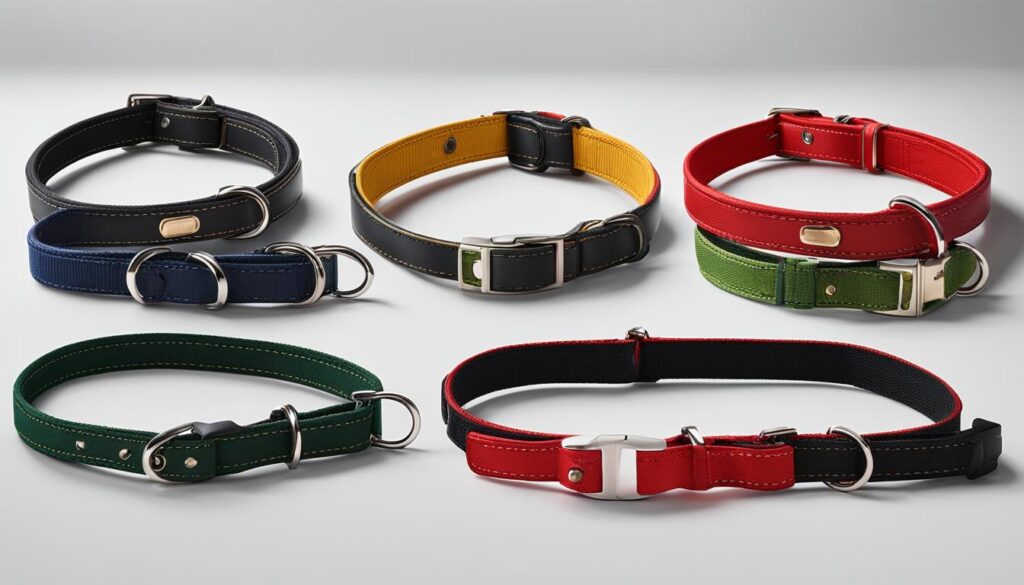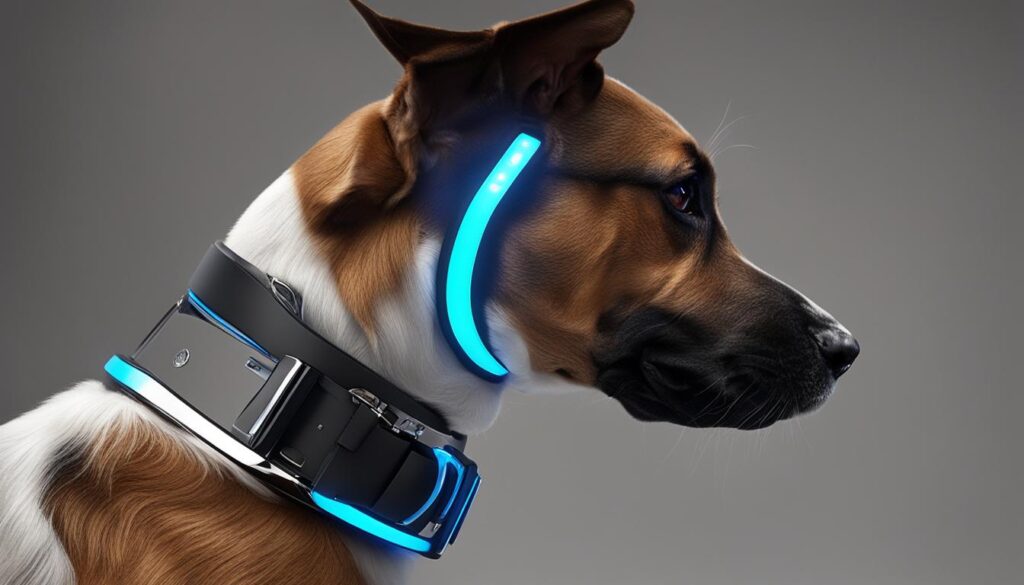Welcome to the Ultimate Dog Care E-Collar Guide for Responsible Pet Parents. If you’re a dog owner looking to effectively train and control your furry friend’s behavior, then you’ve come to the right place. In this comprehensive guide, we will explore the different types of dog training collars available, their benefits, and how to choose and use them responsibly.
- What Does a Dog Training Collar Do?
- Types of Training Collars for Dogs
- Benefits of Dog Training Collars
- Are Dog Training Collars Safe?
- Choosing the Right Dog Training Collar
- Proper Use of Dog Training Collars
- Best Dog Training Collars
- Introducing a Dog Training Collar: A Gradual Approach
- The Future of Dog Training: High-Tech Solutions
- Responsible Dog Ownership: Understanding Your Role
- Conclusion
- FAQ
- Source Links
Key Takeaways:
- Choose the right dog training collar based on your dog’s size, breed, and behavior.
- Use training collars responsibly, following manufacturer’s instructions and guidelines.
- Training collars can reinforce desired behaviors and help correct negative ones.
- Ensure the safety and well-being of your dog when using a training collar.
- Consider high-tech solutions, like the Fi collar, for future dog training needs.
What Does a Dog Training Collar Do?
Dog training collars are specially designed collars that aid in training and controlling a dog’s behavior. These collars are used to curb unwanted behavior on the leash, outside, or when approaching the front door. They feature adjustable straps, fasteners, and attachment points for leashes, and some collars incorporate electronic receivers, contact points, and control devices. The use of a training collar can help reinforce desired behaviors and provide timely communication between the dog and the owner.
Training collars for dogs are versatile tools that offer various training options. Dog training collar technology has evolved significantly, providing pet parents with a range of options to suit their training needs. The collar can emit different types of stimuli, including vibrations, sounds, sprays, or mild electric sensations, to redirect a dog’s attention and discourage unwanted behaviors. The specific type of training collar used will depend on the training objectives, the dog’s temperament and size, and the owner’s preferences.
When used correctly and responsibly, a dog training collar can help improve obedience, reinforce commands, and address behavioral issues effectively. It is essential to remember that training collars are training tools and should never be used as a substitute for positive reinforcement methods. Positive reinforcement, along with proper socialization and consistent training, is crucial for creating a well-behaved and happy canine companion.
What Does a Dog Training Collar Do?
Table: Types of Dog Training Collars
| Type of Training Collar | Description |
|---|---|
| Prong Collars | Used for dogs that pull on the leash. The collar includes interlocking metal links that provide a gentle correction when the dog pulls. |
| Remote-Controlled Collars | Allows off-leash training and behavior correction. The owner can remotely deliver commands, vibrations, or stimulations to the dog’s collar. |
| Gentle Leader Collars | Designed to discourage pulling or lunging during walks. They provide control by gently redirecting the dog’s head. |
| Anti-Bark Collars | Aims to reduce excessive barking. The collar detects barking and emits a stimuli, such as a sound or vibration, to interrupt the behavior. |
| Electronic Dog Collars | Provide a range of stimuli, including shocks, sprays, or sounds, to modify behavior. The intensity can be adjusted to suit the dog’s sensitivity. |
Types of Training Collars for Dogs
When it comes to training collars for dogs, there are several options available to suit different training needs and behaviors. Understanding the various types of training collars can help you make an informed decision on which one is best for your furry friend. Here are some common types of training collars:
- Pinch Collars or Prong Collars: These collars, also known as prong collars, are designed to discourage pulling while walking on a leash. They have metal prongs that apply pressure when the dog pulls, causing discomfort and redirecting their attention.
- Anti-Bark Collars: As the name suggests, anti-bark collars are specifically designed to discourage excessive barking. They emit a sound, vibration, or mild static correction when the dog barks, helping to curb the behavior.
- Invisible Fence Collars: Invisible fence collars are used in conjunction with an underground containment system. These collars deliver a mild static correction when the dog approaches or crosses the designated boundary, preventing them from straying.
- Remote-Controlled Training Collars: Remote-controlled training collars provide a range of training options, allowing you to reinforce commands or signals from a distance. These collars often have adjustable stimulation levels, including vibrations, tones, or mild static corrections.
- Gentle Leader Collars: Gentle leader collars, also known as head halters, are designed to discourage pulling or lunging during walks. They have a strap that goes over the dog’s nose, providing control and steering.
- Electronic Dog Collars: Electronic dog collars, also referred to as e-collars, come with a range of stimuli to modify behavior. They can deliver vibrations, sounds, sprays, or mild static corrections to provide timely feedback during training sessions.
| Training Collar Type | Usage | Benefits |
|---|---|---|
| Pinch Collars or Prong Collars | Discouraging pulling on the leash | Redirects attention, discourages pulling |
| Anti-Bark Collars | Curbing excessive barking | Discourages barking, promotes quiet behavior |
| Invisible Fence Collars | Maintaining boundaries | Prevents straying, keeps dogs within designated area |
| Remote-Controlled Training Collars | Off-leash training, reinforcing commands | Allows distance communication, provides training options |
| Gentle Leader Collars | Discouraging pulling or lunging on walks | Provides control, redirects behavior |
| Electronic Dog Collars | Behavior modification, training reinforcement | Offers various stimuli, provides timely feedback |
Remember that choosing the right training collar for your dog requires careful consideration of their specific needs, behavior, and training goals. It is always recommended to consult with a professional trainer or veterinarian to ensure you are using the collar safely and effectively.
Benefits of Dog Training Collars
Dog training collars offer a range of benefits for responsible pet parents. These collars are designed to aid in training and controlling a dog’s behavior, providing clear and timely communication between the dog and the owner. By using a training collar, you can effectively reinforce desired behaviors and discourage negative ones. Let’s explore the key benefits of using dog training collars:
1. Enhanced Communication
Training collars allow for effective communication between you and your dog. With the use of signals or stimulation, you can convey commands and expectations clearly. This enhances your ability to guide your dog during training sessions and reinforces the desired behaviors.
2. Behavior Correction
Dog training collars are particularly useful for correcting unwanted behaviors such as excessive barking, digging, or jumping. These collars provide timely correction, helping your dog understand which behaviors are unacceptable. By consistent and appropriate use, you can effectively modify and shape your dog’s behavior.
3. Off-Leash Training
For pet owners who enjoy giving their dogs freedom to explore off-leash, training collars can significantly improve control and safety. These collars allow you to maintain control and recall your dog when needed, giving them the freedom to roam while ensuring their safety and the safety of others.
| Benefits of Dog Training Collars |
|---|
| Enhanced Communication |
| Behavior Correction |
| Off-Leash Training |
Overall, dog training collars, when used responsibly and ethically, can be a valuable tool for pet parents in training and controlling their dogs’ behavior. They facilitate effective communication, behavior correction, and off-leash training. However, it is important to understand that the proper selection, usage, and training methods are crucial for the safety and well-being of your dog.
Are Dog Training Collars Safe?
When it comes to the safety of dog training collars, responsible usage is key. It’s important to consider factors such as the dog’s size, breed, and behavior before selecting a collar. Not all collars are appropriate for every dog. For example, some collars may not be suitable for small dogs or those with delicate necks. It’s crucial to follow the manufacturer’s instructions and guidelines for usage to ensure the collar is used correctly and safely.
Misusing a training collar can have negative consequences, both physically and emotionally, for the dog. It’s always recommended to consult with a professional trainer or veterinarian before using a training collar. These experts can provide guidance on selecting the right collar for your dog’s needs and ensuring it is used appropriately.
Remember, the ultimate goal of using a training collar is to train and control your dog’s behavior effectively and ensure their safety. With proper selection and responsible usage, dog training collars can be a valuable tool for training and improving the bond between you and your furry friend.
Common Safety Concerns with Dog Training Collars
When using a dog training collar, it’s important to address common safety concerns to ensure the well-being of your pet. Some potential safety concerns include:
- Physical discomfort or injury: Improperly fitted collars or excessive use of pressure can cause discomfort or injury to the dog’s neck. It’s crucial to regularly check the collar for any signs of discomfort or damage and make necessary adjustments.
- Emotional distress: The use of aversive stimuli, such as shocks or sprays, can cause emotional distress in dogs. It’s important to use positive reinforcement training methods alongside the collar to create a positive association and minimize stress.
- Inappropriate use: Using a training collar for extended periods or leaving it on the dog unsupervised can lead to unintended consequences. Collars should only be worn for short periods during training sessions, and the dog should never be left unattended with the collar on.
By being aware of these safety concerns and taking the necessary precautions, you can ensure that the use of a dog training collar is a safe and effective tool in training your beloved canine companion.
Choosing the Right Dog Training Collar
When it comes to choosing a dog training collar, there are several important factors to consider. The first is the size and breed of your dog. Different collars are designed to fit different sizes and temperaments, so it’s essential to find one that suits your dog’s specific needs. A small, delicate dog may require a gentler collar, while a larger, more active breed may benefit from a sturdier option.
Another crucial consideration is your dog’s temperament and behavior. Are they easily excitable or more laid-back? Do they have any specific training needs, such as excessive barking or pulling on the leash? Understanding your dog’s unique personality will help you choose a collar that addresses their specific challenges and facilitates effective training.
It’s also important to align your training goals and methods with the type of collar you select. Positive reinforcement training methods, such as rewarding desired behaviors with treats or praise, work well with most collars. However, some collars, like shock collars, may not be suitable for positive reinforcement training. It’s essential to choose a collar that aligns with your training philosophy and goals.
Table: Comparison of Different Dog Training Collar Features
| Collar Type | Key Features | Recommended for |
|---|---|---|
| Pinch Collars/Prong Collars | Provide gentle pressure to discourage pulling | Dogs that pull on the leash |
| Anti-Bark Collars | Triggered by excessive barking to discourage the behavior | Dogs with excessive barking issues |
| Invisible Fence Collars | Work with an underground system to create a boundary for the dog | Dogs that need containment within a specific area |
| Remote-Controlled Collars | Allow off-leash training and behavior correction | Dogs in need of off-leash training or behavior reinforcement |
| Gentle Leader Collars | Discourage pulling or lunging during walks | Dogs that tend to pull or lunge on the leash |
| Electronic Dog Collars | Provide a range of stimuli to modify behavior, including shocks, sprays, or sounds | Dogs with a variety of behavior issues |
By considering your dog’s size and breed, temperament and behavior, and aligning your training goals and methods, you can choose the right dog training collar to effectively train and control your furry friend’s behavior. Remember, it’s always a good idea to consult with a professional trainer or veterinarian for guidance and recommendations tailored to your dog’s specific needs.
Proper Use of Dog Training Collars
Proper use of a dog training collar is crucial for effective and safe training. By following these guidelines, you can ensure that you are using the collar responsibly and in the best interest of your dog.
Understanding the Features
It is essential to familiarize yourself with the specific features and functions of the training collar you are using. Take the time to read the manufacturer’s instructions and guidelines thoroughly. This will help you understand how to properly adjust the collar’s settings, including the intensity levels for any electronic stimuli.
Short and Supervised Sessions
Training collars should never be worn for extended periods. It is recommended to use them during short training sessions, typically lasting no more than 15-20 minutes. This will help prevent discomfort or irritation for your dog. Additionally, always supervise your dog while they are wearing the collar to ensure their safety and well-being.
Regular Checks for Comfort and Damage
Regularly check the collar for any signs of discomfort for your dog, such as skin irritation or excessive scratching. If you notice any discomfort, discontinue use immediately and consult with a professional trainer or veterinarian. It is also important to examine the collar for any signs of damage, such as frayed straps or malfunctioning electronic components. Replace or repair the collar as needed to maintain its effectiveness and safety.
| Proper Use of Dog Training Collars | Tips |
|---|---|
| Understanding the Features | Familiarize yourself with the specific functions and adjustment settings of the training collar. |
| Short and Supervised Sessions | Use the collar during short training sessions and always supervise your dog while they are wearing it. |
| Regular Checks for Comfort and Damage | Regularly check the collar for signs of discomfort or damage, and discontinue use if necessary. |
By using a dog training collar responsibly and in line with these guidelines, you can enhance your training efforts and effectively communicate with your dog. Remember, always prioritize your dog’s well-being and seek professional guidance if needed.
Best Dog Training Collars
When it comes to choosing the best dog training collar, there are several top-rated options available on the market. These collars have been highly recommended by pet owners and professional trainers for their effectiveness and safety. Whether you’re looking for a prong collar, a gentle leader collar, or an electronic training collar, there’s a collar out there that can meet your specific training needs.
Here are the top picks for the best dog training collars:
- Herm Sprenger Prong Collar: This collar is an excellent choice for dogs that pull while walking on the leash. It provides gentle yet effective correction without causing harm or discomfort to your dog.
- PetSafe Gentle Leader Collar: Designed to discourage pulling and lunging during walks, this collar offers a gentle and humane way to control your dog’s behavior. It provides a comfortable fit and allows for natural movement.
- Shock Collar by DOG CARE Store: This electronic training collar provides a range of stimuli, including shocks, vibrations, and sounds, to modify your dog’s behavior. It offers multiple training modes and adjustable intensity levels for personalized training sessions.
- WOLFWILL Dog Training Collar: This collar features a remote control system that allows for off-leash training and exploration. It has a long-range capability and offers multiple training modes, making it suitable for dogs of all sizes and breeds.
These top-rated dog training collars have proven to be effective tools in training and controlling dogs’ behavior. However, it’s important to remember that the success of training ultimately depends on responsible usage and positive reinforcement techniques. Before using any training collar, consult with a professional trainer or veterinarian to ensure proper selection and usage.

Recommended Dog Training Collars
| Collar | Type | Features |
|---|---|---|
| Herm Sprenger Prong Collar | Prong Collar | Gentle and effective correction |
| PetSafe Gentle Leader Collar | Gentle Leader Collar | Discourages pulling and lunging during walks |
| Shock Collar by DOG CARE Store | Electronic Training Collar | Multiple training modes and adjustable intensity levels |
| WOLFWILL Dog Training Collar | Remote Control Collar | Long-range capability and multiple training modes |
Remember, choosing the right training collar for your dog is essential for successful training. Consider your dog’s size, breed, temperament, and training goals when making your selection. Always prioritize your dog’s safety and well-being, and never hesitate to seek professional guidance if needed. With the right training collar and responsible usage, you can effectively train and control your dog’s behavior, creating a happier and more well-behaved canine companion.
Introducing a Dog Training Collar: A Gradual Approach
When it comes to introducing a dog training collar, it’s important to take a gradual approach to ensure a positive and stress-free experience for your furry friend. Whether you’re using a traditional training collar or an electric shock collar, the key is to make the process as comfortable and rewarding as possible.
Start by getting your dog familiarized with wearing a collar. Choose a collar that fits properly and doesn’t cause any discomfort. Allow your dog to wear the collar for short periods of time initially, gradually increasing the duration as they become more comfortable.
If you’re using an electric shock collar, begin with the lowest degree of shock stimulation. It’s crucial to allow your dog to acclimate to the sensations in a controlled and gradual manner. Pair the collar with positive reinforcements, such as treats or praise, to create a positive association. This will help your dog understand that wearing the collar is a positive experience. Monitor your dog’s reactions closely and adjust the training accordingly to ensure their comfort and well-being.
Remember, every dog is unique, and the introduction process may vary depending on their temperament and past experiences. Patience, consistency, and positive reinforcement are key to successfully introducing a training collar and building a strong bond with your canine companion.
The Future of Dog Training: High-Tech Solutions
As technology continues to advance, high-tech solutions are transforming the field of dog training. These modern dog training tools offer innovative ways to enhance communication, improve training outcomes, and prioritize the well-being of our furry friends. One such example is the Fi collar, a cutting-edge GPS tracking and activity monitor that is revolutionizing the way we train and care for our dogs.
The Fi collar combines state-of-the-art technology with a humane and less intrusive approach to training. It features GPS tracking capabilities, allowing pet owners to create safe zones for their dogs and receive real-time alerts if their furry companions stray from the designated area. This not only ensures the safety of our dogs but also provides us with peace of mind.
“The Fi collar has been a game-changer for me and my dog. I no longer have to worry about him wandering off or getting lost. The tracking feature gives me confidence during off-leash training sessions, and the activity monitor helps me keep him fit and healthy. It’s truly a modern dog owner’s dream come true!” – Sarah, proud Fi collar user
With its sleek design and user-friendly interface, the Fi collar is a testament to the potential of high-tech solutions in the realm of dog training. As pet owners, we can now harness the power of technology to strengthen the bond with our dogs, provide them with a higher level of safety, and ensure effective training.

The Benefits of High-Tech Dog Training Tools:
- Enhanced communication: High-tech dog training tools facilitate clearer and more precise communication between pet owners and their dogs.
- Increased safety: GPS tracking and activity monitoring features provide real-time information about the whereabouts and well-being of our dogs.
- Efficient training: High-tech tools offer customizable training options and real-time feedback, leading to more efficient and effective training sessions.
- Improved well-being: By leveraging technology, we can prioritize our dogs’ physical and mental well-being, ensuring they lead healthy, happy lives.
| High-Tech Dog Training Tools | Key Features |
|---|---|
| Fi collar | GPS tracking, activity monitoring, safe zone creation, real-time alerts |
| Smart clicker | Smartphone-connected clicker with customizable training programs and progress tracking |
| Vibration collar | Collar that delivers gentle vibrations as a training cue, ideal for sensitive dogs |
The future of dog training is undoubtedly evolving towards high-tech solutions, offering pet owners new ways to train, communicate, and care for their dogs. By embracing these advancements responsibly, we can create a harmonious and fulfilling relationship with our four-legged companions.
Responsible Dog Ownership: Understanding Your Role
Being a responsible dog owner goes beyond simply controlling your dog’s behavior. It is a commitment to understanding and meeting your dog’s needs, providing a safe and loving environment, and using positive reinforcement training methods. By taking on the role of a responsible dog owner, you not only ensure the well-being of your furry companion but also strengthen the bond between you and your dog.
One of the key aspects of responsible dog ownership is understanding your role in training your dog. Training is not just about teaching your dog commands; it is about fostering a positive relationship built on trust and respect. Positive reinforcement training methods, which involve rewarding desired behaviors instead of punishing unwanted ones, have been proven to be effective and humane. By using treats, praise, and play as rewards, you can motivate your dog to learn and follow commands willingly.
Table: Responsibilities of a Responsible Dog Owner
| Responsibility | Description |
|---|---|
| Providing proper nutrition | Ensuring your dog receives a balanced diet that meets their specific nutritional needs. |
| Regular exercise | Engaging your dog in physical activities to maintain their health and prevent behavioral issues caused by pent-up energy. |
| Regular veterinary care | Taking your dog for routine check-ups, vaccinations, and preventive treatments to keep them healthy and prevent the spread of diseases. |
| Socialization | Exposing your dog to different people, animals, and environments to help them develop good social skills and reduce fear or aggression. |
| Providing mental stimulation | Engaging your dog’s mind with interactive toys, puzzles, and training sessions to prevent boredom and destructive behavior. |
| Maintaining a safe environment | Removing hazards, securing fences, and using pet-safe products to prevent accidents and injuries. |
| Responsible breeding (if applicable) | If you choose to breed your dog, doing so responsibly by considering the health, temperament, and genetic background of both parents. |
Responsible dog ownership also involves providing your dog with a safe and secure environment. This includes ensuring they have proper identification, such as a collar with tags or a microchip, in case they get lost. It also means taking precautions to keep your dog safe from hazards in your home and neighborhood. Keeping toxic substances out of reach, providing a secure fence or leash, and supervising your dog during outdoor activities are all important steps to protect your furry friend.
Remember, being a responsible dog owner is a lifelong commitment. It requires patience, understanding, and ongoing education about your dog’s needs. By taking the time to learn, train, and care for your dog, you are not only fulfilling your responsibilities but also creating a loving and fulfilling relationship with your four-legged companion.
Conclusion
In conclusion, as responsible pet parents, it is crucial to understand the proper use and benefits of dog training collars. This comprehensive dog care e-collar guide has explored the different types of training collars available, their benefits, and how to choose and use them responsibly.
By using positive training methods that prioritize the well-being and happiness of our dogs, we can build a strong bond and positive relationship with our four-legged companions. It is essential to select the right collar based on our dog’s size, breed, temperament, and training goals. Consulting with a professional trainer or veterinarian can provide valuable guidance in this process.
Remember, as responsible pet parents, we have a duty to provide a safe and loving environment for our dogs. Using positive reinforcement techniques and responsibly incorporating training collars, we can effectively train and control our dogs’ behavior while ensuring their physical and emotional well-being.
So, embrace your role as a responsible pet parent and make informed decisions about dog training collars. Together, we can create a harmonious and loving relationship with our furry friends using positive training methods and responsible collar usage.
FAQ
What is a dog training collar?
A dog training collar is a specially designed collar that aids in training and controlling a dog’s behavior. It can be used to curb unwanted behavior on the leash, outside, or when approaching the front door.
What are the different types of training collars for dogs?
There are several types of training collars available for dogs, including pinch collars, anti-bark collars, invisible fence collars, remote-controlled collars, gentle leader collars, and electronic dog collars.
What are the benefits of using a dog training collar?
Dog training collars facilitate clear and timely communication between the dog and the owner, help correct negative behaviors, and are especially useful for off-leash training.
Are dog training collars safe?
The safety of dog training collars depends on proper use. It is important to consider factors such as the dog’s size, breed, and behavior when selecting a collar and to follow the manufacturer’s instructions.
How do I choose the right dog training collar?
When choosing a dog training collar, consider factors such as the dog’s size, breed, temperament, behavior, and your training goals and methods. Consulting with a professional trainer or veterinarian can help guide you in selecting the right collar.
How do I properly use a dog training collar?
Proper use of a dog training collar involves familiarizing yourself with its features, following the manufacturer’s instructions, using it for short periods only, and regularly checking for any signs of damage or discomfort for the dog.
What are some top-rated dog training collars?
Some popular options include the Herm Sprenger Prong Collar, PetSafe Gentle Leader Collar, Shock Collar by DOG CARE Store, and WOLFWILL Dog Training Collar.
How do I introduce a dog training collar to my dog?
Introduce a dog training collar gradually by getting the dog familiarized with wearing it, starting with the lowest degree of stimulation for electric shock collars, and pairing it with positive reinforcements like treats or praise.
What are high-tech solutions for dog training?
One example is the Fi collar, a GPS tracking and activity monitor that offers a more humane and less intrusive method of training. It allows pet owners to create safe zones and receive real-time alerts if the dog strays from the designated area.
What does responsible dog ownership entail?
Responsible dog ownership involves understanding and meeting the dog’s needs, providing a safe and loving environment, and using positive reinforcement training methods.




